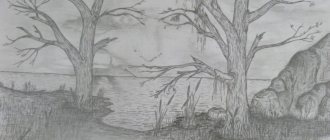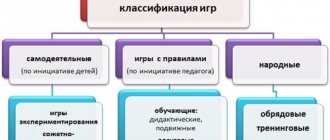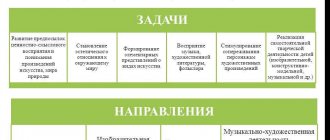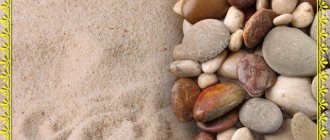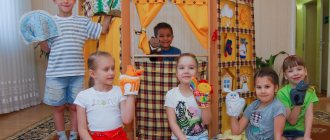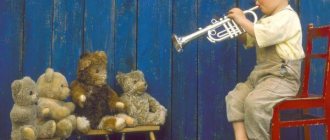Who in childhood did not freeze on the street for half an hour, and someone longer, looking at all sorts of patterns on snowflakes? The miraculous beauty cannot leave anyone indifferent! Let's try to draw them!
Finger gymnastics “Snowflakes”
| I’m standing and catching snowflakes in my palm | Rhythmic strikes with left fingers. hands, starting with the index finger, along the palm of the right hand. |
| I love winter, I love snow and snowflakes | Rhythmic strikes with the fingers of the right hand, starting with the index finger, on the palm of the left hand |
| But where are the snowflakes? | When asked, clench your fists, |
| There is water in the palm | the answer is to unclench |
| Where have the snowflakes gone? Where? | For the first question, clench your fists; for the second, unclench your fists. |
| The fragile pieces of ice-rays have melted... As you can see, my palms are hot. | Small shaking with relaxed palms |
Benefits of the lesson
Sand as an art material has several advantages. And most importantly – a relaxing, therapeutic effect. The child gets rid of the effects of stress, and emotional stability returns to him. Sand painting is used to treat sleep disorders, neurotic disorders, and anxiety in children. Sand art is also useful for healthy children; it allows them to calm down after failures, get rid of low self-esteem and the phobia of becoming a loser. The child sees that a bad drawing can be corrected at any time.
The second benefit of sand painting for children is a developmental activity. The technique improves finger motor skills, sensory perception and creative thinking. Drawing usually involves both hands, which has a positive effect on the development of both the right and left hemispheres of the brain. For schoolchildren, fiddling with sand improves writing skills. It is useful to use the technique with children for whom studying is a burden. In this case, sand painting becomes a good addition to homework and allows you to consolidate school knowledge through art.
The third benefit of drawing on sand is the revelation of artistic potential and the manifestation of imagination. The technique has no restrictions and strict rules. You can draw with your hands and various devices. The loose texture of the material allows you to create images of any complexity and degree of detail. Drawing with sand is available for toddlers, middle school preschoolers, and schoolchildren.
Summary of a lesson on finger painting in the sand with children 2–3 years old “Sun-Bell”
Anna Sibrina
Summary of a lesson on finger painting in the sand with children 2–3 years old “Sun-Bell”
Objectives: Learn to hold a figure with one hand and trace the outline with the other. Fix the name of the geometric figure “circle”
.
Develop a sense of shape and color, fine motor skills. Cultivate an interest in drawing .
Equipment: a large shoe box, dry sand, circles cut out of cardboard.
Technique: finger painting .
Educator: Guys, try to guess the riddle.
This is who wakes us up in the morning,
Who brings warmth to people
Shines brightly and laughs?
Forever, children, this is the SUN !
Today we will draw the sun . Oh, is someone knocking on our door? Let's see who came to us. Who are these guys? ( Sun )
Look at what geometric figure does our sun ? (Round)
What colour?
(Yellow)
Today we will draw a sun , take circles and circle it around the edge.
Place your circle in a box of sand , hold the circle with one hand, and trace the edge with your finger . Now remove the circles and see what you got? (Circle)
the sun missing ? (Luchikov)
That's right, let's finish drawing the rays.
Finger gymnastics " Sunny "
(Bend your fingers )
Hello, golden sun !
Hello, blue sky!
Hello, free breeze!
Hello, little oak tree!
We live in our native land,
Objectives: Continue learning to draw round objects. Develop a sense of shape and fine motor skills. Cultivate goodwill.
Equipment: large shoe box, dry sand.
Technique: finger painting .
Educator: Guys, look who came to visit us? (Bunny)
What a funny bunny
Don't be afraid, runaway!
On the top of the head there are long ears,
Fluffy back, soft tummy,
We won't offend you
Let's play with the bunny.
- Pet the bunny, guys, so he won’t be afraid. The bunny whispers in my ear. The bunny wants to learn how to draw bagels . We'll teach him. Really guys? (Yes)
You little bunny, sit down and learn from the guys.
- I have a steering wheel in my hand. What geometric figure does it resemble? (Circle)
draw a circle in the air .
- Now let's draw a steering wheel on the sand .
- Bunny, go look at how many donuts our kids have drawn ! He really liked it. And now he knows how to draw the steering wheels . Do you want to play with the bunny? (Yes)
Game “The gray bunny is sitting”
The little gray bunny sits and wiggles his ears,
Like this, like this, he moves his ears.
(Squat down, move hands above head)
It's cold for the bunny to sit - we need to warm his paws,
Like this, like this, we need to warm our little paws,
(They stand up, stroke the other with one hand, then reverse)
It’s cold for the bunny to stand - the bunny needs to jump,
Like this, like this - the bunny needs to jump.
(Press your hands to your chest (like paws)
and jump on the spot)
Integrated educational activities in the middle group “Hello bell sun”! Integrated educational activities in the middle group. Topic: “Hello bell sun!” Goals of educational activities:.
Collective drawing in the first junior group “Sun - Bell” Goal: through play activities and didactic games to develop interest in visual arts. Objectives: To arouse interest in the image.
Summary of an open lesson on drawing “Sunshine, sunshine, scatter the rings” (junior group) CHOU “Kindergarten KOLIBRI” Summary of an open lesson on artistic creativity in the 2nd junior group Drawing. Topic: "Sunshine"
Summary of a story-based physical education lesson with children 3-4 years old “A cloud walked across the sky, a cloud covered the sun” Summary of a story-based physical education lesson with children 3-4 years old on the topic: “A cloud walked across the sky, a cloud covered the sun...” Goal: development.
Summary of entertainment for Children's Day in the early age group "Sun - Bell" Municipal autonomous preschool educational institution "Kindergarten No. 60" Summary of entertainment for Children's Day.
Summary of a drawing lesson on the topic “Rowan Branch” with children 5–6 years old. Age of children: 5-6 years. Integration of all educational areas. Goal: create a favorable atmosphere for communication, set children up for... Summary of a drawing lesson in a non-traditional technique on the topic: “Autumn Forest” with children 5–6 years old Theme of the drawing lesson: “Autumn Forest” Age of children: 5-6 years. Integration of all educational areas. Goal: to activate and encourage. Summary of a drawing lesson in the second group of early age “Sun - bell”. Objectives: 1. To arouse interest in the image of the spring sun. 2. Learn to combine different shapes and lines in one image: draw a large circle.
Source
Sand painting materials
To learn to draw on sand, you need to purchase a list of materials and equipment. All of them are affordable, you won’t have to fork out a lot of money. Here's what the young artist will need:
- table with sides and a lighting device at the bottom;
- sand;
- antistatic agent in a can;
- additional equipment - art brushes, sticks, sieve, templates;
- a wide and flat brush for sweeping grains of sand from the corners of the table.
An antistatic agent is necessary to prevent sand grains from sticking together, which is inevitable when quartz material is used repeatedly. The spray should be sprayed before each lesson. A regular antistatic agent is suitable, preventing synthetic clothing from sticking to the body.
You can buy a table or make it yourself. Homemade design - sides connected in a rectangular shape with a bottom made of frosted glass or plastic up to 5 mm thick. It is necessary to fix the lamp from below so that diffused light is obtained. The lighting can be anything: in the warm and cold range, even colored. The legs of the table should not wobble, otherwise when drawing you will not be able to draw neat lines.
The finished table is a structure with sides and a bottom in the form of an illuminated tablet. The optimal format is 130x70 cm, but for a child 70x50 cm is enough. The height of the sides should be at least 6-7 cm, but from the side of the drawer it is only 3 cm, otherwise it will be inconvenient to draw the lower elements. It is necessary to leave indentations for sand 10-15 cm wide on the right and left sides. It is advisable that these areas be in the same plane as the space for drawing, this makes it more convenient to use many techniques. But some ready-made tables have tray recesses on both sides.
Any sand will do. You can buy an aquarium one at a pet store, and a special one for creativity at a supermarket in the children's section. You can contact a children's and adult creativity studio where sand animation is practiced, if there is such an institution in the locality. They probably won't refuse to sell a small amount of sand. The fraction of the material can also be any. It is advisable to get different ones, since fine sand is convenient for creating tones and halftones, and coarse sand is convenient for creating large image details.
If there is a river near your house, you can dig up sand on the shore. You just have to filter it through a fine-mesh sieve, then rinse. The washing procedure looks like this:
- Pour 4-5 kg of sand into a bucket. This is the standard amount for drawing.
- Fill with water to the edge of the bucket.
- Stir gently with your hand or a large spoon.
- When dust and dirt particles rise to the surface and heavier grains of sand settle to the bottom, carefully drain the water.
- Repeat the procedure until the drained water becomes crystal clear.
- Dry the cleaned material on the balcony if the weather is sunny, or on a radiator, or in the oven.
You can replace sand with semolina, finely ground salt, and to create darker and more contrasting elements of the image - ground coffee.
Bulk material should be renewed once every 3 months, and if the child draws every day, then once every 1.5 months. If this is not done, the sand will become less pliable, since with constant friction the grains of sand are destroyed and the structure of the material softens.
Sand painting technique
The technique of creating sand drawings is not difficult, but when teaching a child you will have to be patient. The main tool is the artist’s hands, but it is possible to use auxiliary devices.
Before your child starts drawing, introduce him to the art material. Offer to immerse your hands in the sand, pour it from one palm to the other, and talk about your feelings. After becoming familiar with the material, you can begin to learn drawing methods.
Fist rash
This is the first DIY sand painting method that a preschooler should master. Ask to take the material into your palm, clench it into a fist, and turn it along a vertical axis so that the grains of sand fall down. Explain to your child that the amount of sand spilled out is regulated by squeezing and relaxing the fist muscles. If more grains of sand spill out, the “mound” becomes denser and darker. This creates images with a smooth transition from light to shadow.
Lines of different sizes
Next, preschoolers master drawing lines of different thicknesses, lengths, and tortuosities. Teach your child to draw dotted lines, curls, and waves. This is the best method of getting used to the original drawing technique for a preschooler of the younger group.
To create a thin straight or curved line, you need to pour a strip of sand from your fist, then put two fingers together - your thumb and forefinger, and run them along the strip. You will get a line of the same thickness throughout. Explain to your child that you should not strain your fingers too much, otherwise the image may turn out uneven. If a thicker line is required, the fingers need to be connected diagonally.
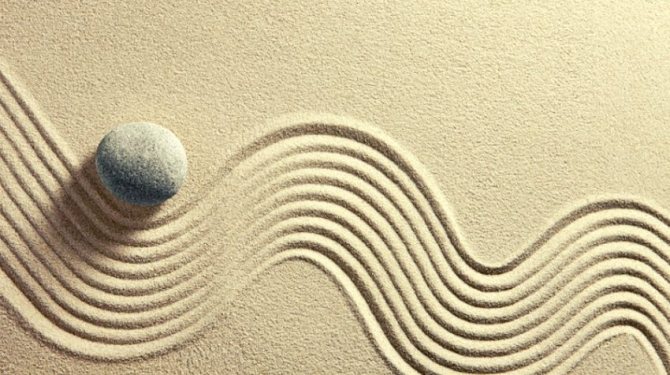
Drawing with different parts of the hand
When drawing on sand, different parts of the hand are used. They move one or more fingers over the material, move them and spread them apart. Large elements and thick lines are depicted with a fist and the edge of the palm extending from the little finger. To create many small details, they poke the sand with their fingertips, and draw fine lines with their nails.
Drawing on dark and light
When the above-described drawing methods have been mastered, you can begin to select a compositional basis. You can draw “in the dark”: fill the background with sand to make light lines on it. Or “in light”, that is, create a dark sandy image on an empty background. Typically, professional artists combine these methods. At the initial stage, it is enough for a child to master them separately.
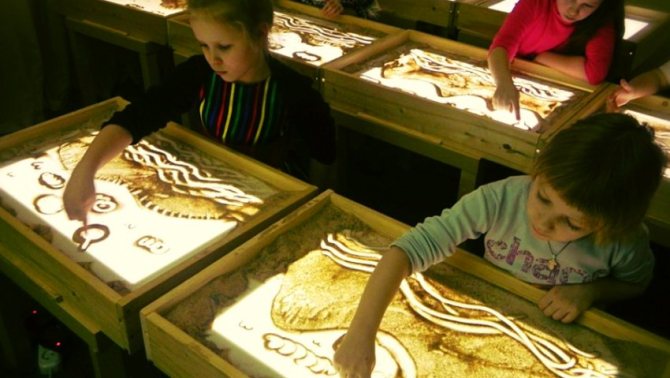
Drawing with aids
To make sand drawing more fun in kindergarten, let children use not only their fingers and palms, but also additional devices. What you can draw:
- Artistic brushes of different hardness. They are convenient to depict hair and wool.
- Toothpicks, hashi sushi sticks, cooking skewers. Optimal for creating thin and graceful lines, fancy patterns, and detailed drawing. It is advisable to use wooden products; they will not scratch the plastic bottom of the drawing table.
- Comb, small rake. With their help, you get neat waves.
- Colored paper. It is placed on the table and sand is poured on top. Uncovered areas of the design are multi-colored. The method is applicable for creating floral motifs and abstract patterns.
- Funnel. Pour sand through it, create slides, paths, patterns - a fascinating activity.
- Fine mesh sieve. With its help, the table is covered with a thin layer of sand, which can become the background basis for the drawing.
- Stencils. You can use ready-made ones. Or cut them out of plastic lids or cardboard for practice. Or use different flat objects for this purpose. You need to place them on a clean table surface, sprinkle them with sand, and then carefully remove them.
- Pendulum. Attach a round-shaped weight to the thread and give it to the child. Let the pendulum swing over the sandy surface, creating patterns of different depths. This is a wonderful method of strengthening the skill of correct pressure and speed of movement when creating a drawing.
- Cylinder with patterns. You can use a toilet sleeve. Apply patterns on it with a thick layer of glue. Wait until it dries, then give it to your child. Let the cylinder roll on the sand, creating patterned paths.
Creative part
We will depict snowflakes. I suggest choosing one of the following options.
Option one. Geometric applique using paper tape or self-adhesive paper. You can use cardboard or colored paper as a basis. Or you can prepare the background yourself by pre-painting it with paint.
After making the snowflakes, you can cut them out, or you can leave them as is.
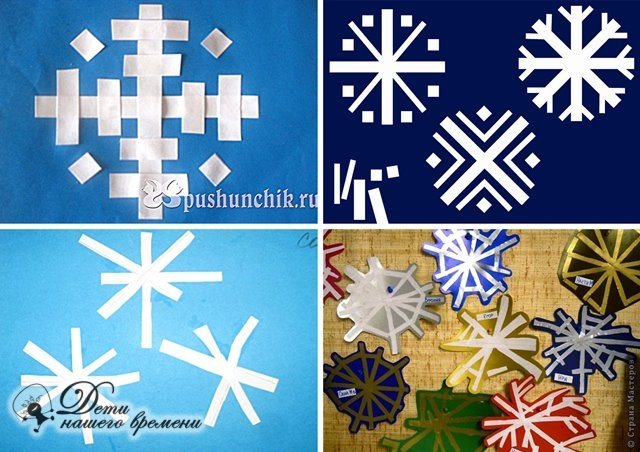
Option two. Figured snowflake. Rays are glued to the base - a circle or square. The rays can be carved, or left in stripes for younger children.
In the center of the snowflake, make eyes, a nose, a mouth - bring the snowflake to life and come up with your own fairy tale or read those already written.
For example, Nina Pavlova has a fairy tale “Millions of millions and one snowflake” .
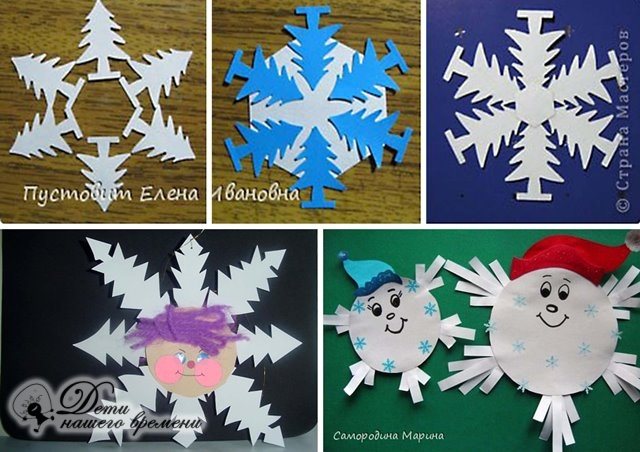
Exercises
Here are some popular sand painting exercises on light tables for children:
- Letters. The lesson is useful for older preschoolers and younger schoolchildren who are learning to write. Spread sand on the table in a dense layer. Let your child learn to write letters beautifully and develop finger motor skills.
- Water landscape. To create it, walk with your outstretched fingers along the sandy surface, imitating waves. At the top of the composition, make thin strokes with your nail - these will be distant ripples. Draw the horizon with the edge of your palm, remove the excess in the upper part - this is the sky above the reservoir.
- Clouds. Take sand into your fist. Pour it out in a thin stream, making circular, non-sweeping movements.
- Maple Leaf. Draw lines that form the outline and veins of the leaf. Sharpen the outline by running your finger along the outer edge of the line, moving the sand inward. Use your fingernail to follow the veins. Outline the border of the petiole.
- Sun. Take sand into your fist and lift it 20-30 cm above the table surface. Pour out evenly, trying not to move your hand. Grains of sand, falling from a height, bounce off the plastic surface, form a ring, and the middle remains empty. And its diameter is wider, the higher the hand is raised.
- Mountain landscape. Spread the sand in a horizontal direction using quick zigzag movements. Use the edge of your little finger to walk along the upper part, removing the excess to create a relief.
Sand animation for preschool children
The highest skill is shooting sand animation, in which the artist continuously creates images that smoothly flow into each other. And he does this by making the minimum possible number of movements. This is a complex art that requires the master to act quickly and have impeccable artistic skills.

Real animation is unlikely to be within the capabilities of a preschooler, but something simple, for example, a tree that is bare in winter and blooms in summer, he can easily depict after practicing for 3-4 lessons.
Introducing a sand painting master class for children:
- Spread the material evenly.
- Place the pad of your finger on the sandy surface and move upward. Thin the line by gradually raising the pad. You will get a tree trunk.
- Draw branches with your little finger. Make them curved rather than straight so they look natural. It will turn out to be a tree in winter.
- Now make it summer. Sprinkle sand in a wide layer on the ends of the branches - this is the crown. Also sprinkle horizontally under the tree - this is grass.
- Randomly poke your fingers along the crown, pressing to different depths, to make leaves. Draw blades of grass by running your fingernail vertically under the tree.
- Adjust the contour of the tree crown and remove excess sand.
- The animation can be continued by making it autumn. To do this, place a few spots under the tree with your fingers - these will be fallen leaves.
Sand therapy for children: educational and creative games
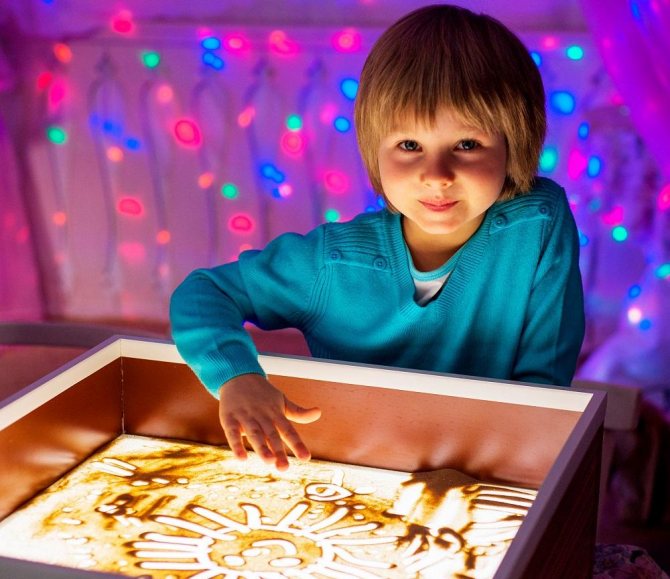
Sand therapy for children makes a significant contribution to the development of cognitive and creative abilities, speech, fine motor skills and tactile sensitivity. Sand helps a child get rid of negative emotions, relax and relieve stress. Joint play and creativity with parents have a beneficial effect on family relationships.
